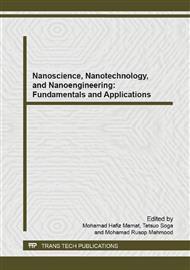p.410
p.415
p.419
p.424
p.429
p.434
p.439
p.444
p.448
Analysis of Photocurrent Responses of Anodized TiO2 Nanotubes Synthesized from Different Organic Electrolytes
Abstract:
Self-organized titanium dioxide (TiO2) nanotubes (NTs) arrays were successfully fabricated via electrochemical anodization of titanium (Ti) foil in an organic electrolyte containing 5wt% of fluoride content. The present work compares two different organic electrolytes (glycerol and ethylene glycol) for the growth of self-organized TiO2 nanotubes by using anodic oxidation strategy. The resultant TiO2 NTs were then subjected to thermal annealing for manipulating the crystalline structure. The SEM images indicated changes in surface morphology of the TiO2 NTs in different electrolytes. It was found that the NT’s dimensional was 56.00nm based on the SEM analyses. Both samples exhibited good photocurrent response; however, TiO2 NTs synthesized in ethylene glycol electrolyte showed promising photocurrent response of 0.385 mA.
Info:
Periodical:
Pages:
429-433
Citation:
Online since:
June 2015
Keywords:
Price:
Сopyright:
© 2015 Trans Tech Publications Ltd. All Rights Reserved
Share:
Citation:


